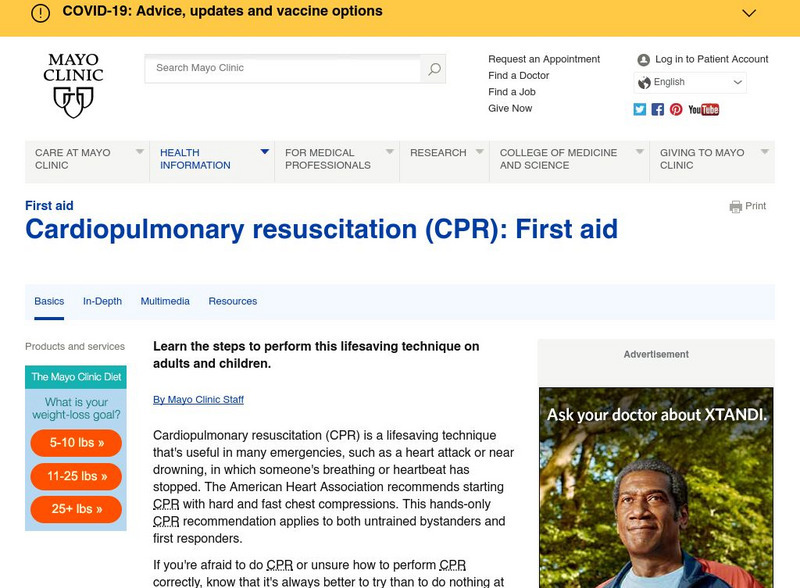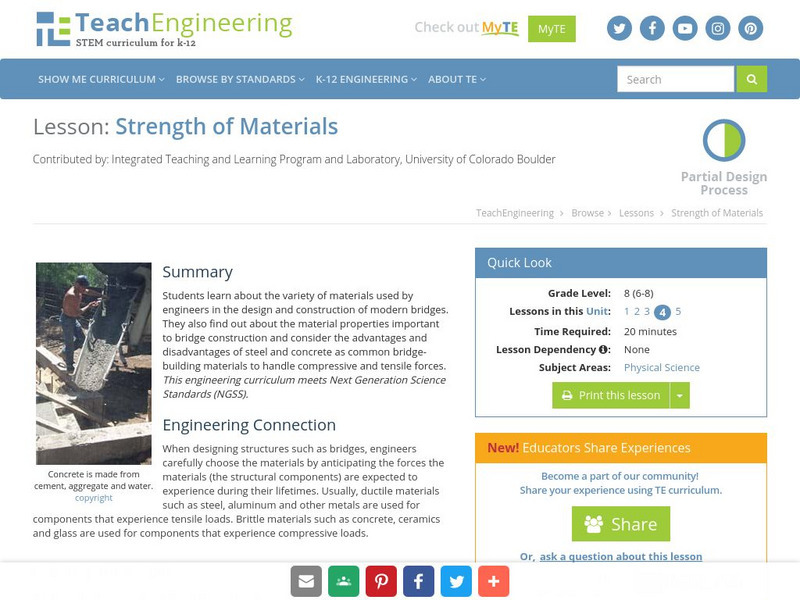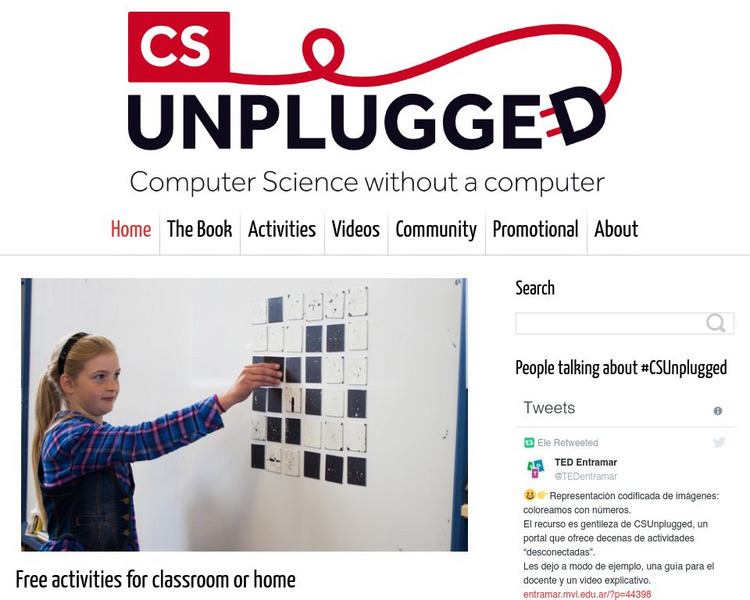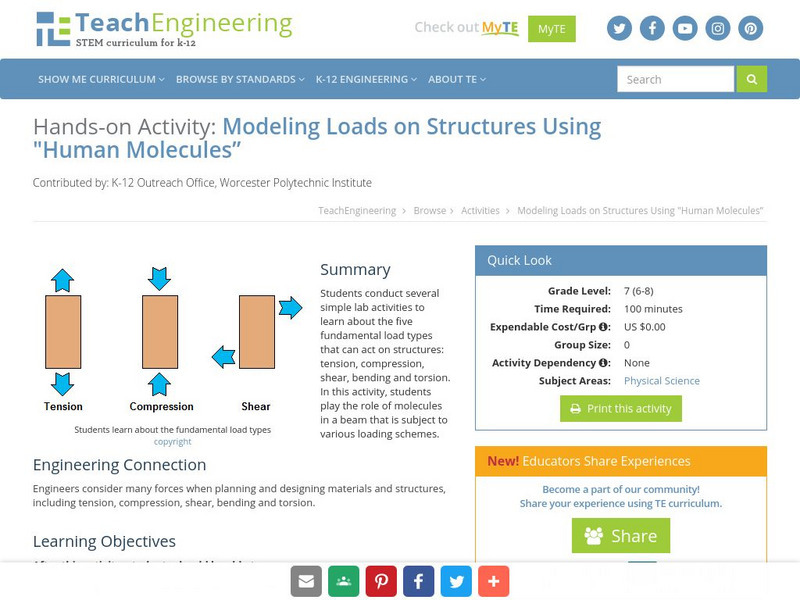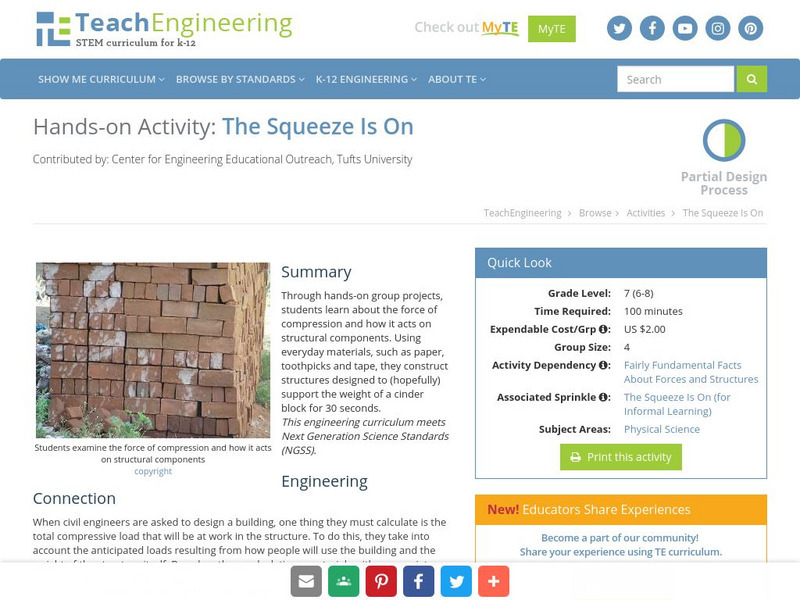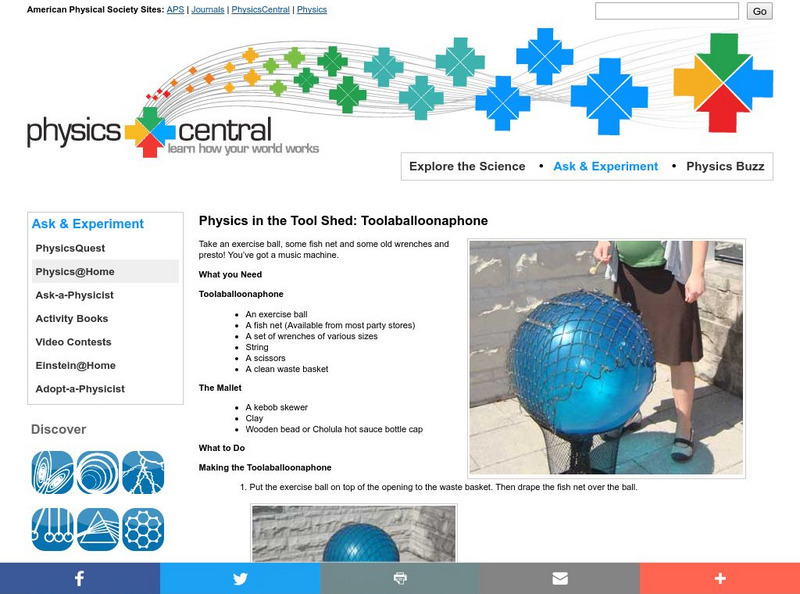Hi, what do you want to do?
Center of Science and Industry
Cosi Columbus: Hover Cup
Science experiment in which you make a hovercraft, a machine that uses compressed air to do work, from a paper cup. Includes full list of materials, procedures, and scientific explanation of how air flow can minimize friction and cause...
Mayo Clinic
Mayo Clinic: Cardiopulmonary Resuscitation (Cpr)
Find detailed notes on CPR. Includes information on the function of rescue breathing and chest compressions and steps for performing CPR on adults and on infants.
TeachEngineering
Teach Engineering: Strength of Materials
Students learn about the variety of materials used by engineers in the design and construction of modern bridges. They also find out about the material properties important to bridge construction and consider the advantages and...
Curated OER
Kids Health: Cpr: A Real Lifesaver
Learn how artificial respiration can help save a life. This website includes definitions terms "artificial respiration," "rescue breathing," and "chest compressions" and lists the emergency situations that would require someone to use...
Other
Cambridge University: Image Types Tutorial
This helpful tutorial on image types primarily focuses on JPEG and TIFF images and discusses compression as well as image format.
CK-12 Foundation
Ck 12: Plix: Independence vs. Dependence: Geological Stresses
[Free Registration/Login Required] An animation to illustrate the effects that different tectonic stresses have on rocks. Also included on the site is a short quiz over tension and compression.
University of Canterbury
University of Canterbury: Cs Unplugged
A collection of free learning activities that teach computer science through games and puzzles that use cards, string, crayons and lots of running around. The activities introduce students to computational thinking through concepts such...
TeachEngineering
Teach Engineering: Leaning Tower of Pasta
Using spaghetti and marshmallows, students experiment with different structures to determine which ones are able to handle the greatest amount of load. Their experiments help them to further understand the effects that compression and...
TeachEngineering
Teach Engineering: Testing Fundamental Loads
Students will conduct several simple lab activities to learn about the five fundamental load types that can act on structures: tension, compression, shear, bending, and torsion. In this activity, students break foam insulation blocks by...
TeachEngineering
Teach Engineering: Strong as the Weakest Link
To introduce the two types of stress that materials undergo - compression and tension - students examine compressive and tensile forces and learn about bridges and skyscrapers. They construct their own building structure using...
Concord Consortium
Concord Consortium: Molecular Workbench: States of Matter
Change variables in this simulation to see how compression affects different states of matter.
TeachEngineering
Teach Engineering: Forces on the Human Molecule
Students will conduct several simple lab activities to learn about the five fundamental load types that can act on structures: tension, compression, shear, bending, and torsion. In this activity, students will play the role of molecules...
TeachEngineering
Teach Engineering: The Squeeze Is On
Students will learn about the force of compression and how it acts on structural components through a hands-on group project. Using everyday products such as paper, toothpicks, and tape they will construct a structure that will support...
TeachEngineering
Teach Engineering: Glue Stick Activity
In this activity students will use hot glue gun sticks to show tension, compression and torsion.
CK-12 Foundation
Ck 12: Analysis: Combining Transformations
[Free Registration/Login may be required to access all resource tools.] Function transformations combining shifts, reflections, stretches and compressions.
Khan Academy
Khan Academy: Wave Characteristics Review
Review the characteristics of periodic transverse and longitudinal waves such as wavelength, crest, trough, amplitude, expansion, and compression.
Other
Avatar Consultants, Inc: Definitions of Sound
Sound is defined and characterized as a wave consisting of oscillations in pressure of a medium. Includes graphics and links to further information.
Physics Central
Physics Central: Physics in the Tool Shed: Toolaballoonaphone
Learn about compression waves and amplification through constructing a toolaballoonaphone! The toolaballoonaphone is made out an exercise ball, fish nets, wrenches, strings, scissors, and a clean waste basket that allows students to...
ClassFlow
Class Flow: Magnets and Springs
[Free Registration/Login Required] This unit gives children experience of forces including attraction and repulsion between magnets, compression and stretching of springs, and stretching of elastic bands. They learn that these forces...
Khan Academy
Khan Academy: How Can Computers Reduce File Size?
Reducing the file size using Lossless and Lossy for file compression.
University of Minnesota
University of Minnesota: Applications of Waves in Your Everyday Life
This site offers a variety of everyday activities and everyday experiences in which waves or sound waves play a role.
Science Buddies
Science Buddies: Boyle's Law
This is a modern version of a classic experiment by Robert Boyle on the compressibility of gases. Boyle discovered the relationship between pressure and volume of gases that now bears his name. This project shows you a simple method for...
Science Buddies
Science Buddies: How Does Ratio of Sand to Cement Affect Strength of Concrete?
Concrete is one of those things that most of us don't think about much, yet we use it every day. We walk on concrete sidewalks, drive on concrete roads, and live and work in buildings with foundations made of concrete. It is a durable...
University of Colorado
University of Colorado: Ph Et Interactive Simulations: University of Colorado: States of Matter: Basics
An interactive simulation will heat, cool and compress atoms and molecules. Watch as they change between solid, liquid and gas phases. Recognize that different substances have different properties which will affect the temperatures for...
Other popular searches
- Compression Waves
- Story Reading Compression
- Compressional Wave
- Tension and Compression
- Tension Compression
- Reading Compression
- Compressional
- Air Compression
- Transverse and Compression
- Compressional Stress
- Soil Compression
- Compression Algorithm






